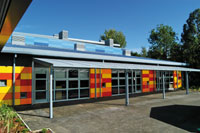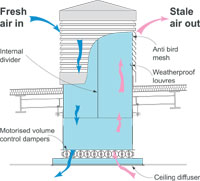Monodraught Windcatchers provide street ventilation for Leatherhead School
Leatherhead Trinity is a 2765 square metre primary school that replaces one junior and two local infant schools has chosen Monodraught windcatchers for their ventilation.
Designed by NPS South East for Surrey County Council the £7.5m scheme, completed in May this year, accommodates 390 pupils. It also houses a 150 square metre dedicated SEN, a language unit and offices for Surrey Arts; and features an outdoor amphitheatre and sports facilities.

The brief specified a two-form entry building with a strong identity – and with sustainability a key factor. The school is organised around a central, top-lit double-height street running the entire length of the building, providing an efficient way of getting from one room to another. The street is a creative space in its own right, allowing adjacent rooms and activities to spill out into it. Natural ventilation and daylighting were considered essential by both client and architect, and among the main environmental strategies adopted has been the use of Monodraught Windcatchers throughout.
The ground floor classrooms and internal street are naturally ventilated using 15 roof-mounted Windcatchers, which not only provide a reliable means of maintaining comfortable daytime temperatures and secure night-time cooling, but are also highly cost effective – particularly compared to installing and maintaining mechanical ventilation systems.
The decision to naturally ventilate the building was taken early and while the strategy proved relatively straightforward for much of the scheme, both the street and ground floor classrooms presented problems in terms of ensuring adequate levels of fresh air. Safety and security issues meant that the rooflight over the street had to be specified without opening lights and the single-aspect classrooms meant that opening windows alone could not be relied on to ventilate the rear of the spaces.
The solution was to use roof mounted Monodraught Windcatchers, which are designed to catch the wind from any direction to bring a controlled rate of flow into spaces while simultaneously expelling warm air.
The Windcatchers naturally ventilate seven classrooms and one studio space on the ground floor, as well as the 60m long by 6.8m high internal street. Project architect Hugh Bennett says the Monodraught system’s inherent simplicity and reliability; and its ability to provide secure night-time cooling in the summer, were important factors in the specification process. Other advantages are that they can be designed and sized to meet the exact needs of a space, without relying on other elements, such as opening vents and rooflights. They also contain few moving parts (none externally) and therefore require minimal long-term maintenance and running costs.
The architect worked closely with Monodraught and used TAS thermal modelling software to analyse the individual needs of the spaces, and formulate a detailed natural ventilation strategy. The starting point for the design was DFES Building Bulletin 87 (guidelines for environmental design in schools), BB101 (ventilation of school buildings) and Part F (ventilation) of the Building Regulations. Limiting carbon dioxide build-up and controlling heat gain was achieved by targeting ventilation rates in the order of 12 litres of fresh air per second per person (12l/s/p) as opposed to 8l/s/p recommended in BB101.
Monodraught produced a detailed proposal indicating the preferred size and specification of the units for each area of the building (a total of 15 Windcatchers were specified) and recommended a system that will provide the required air change rate at a wind speed of 2-3 metres per second. The Met Office suggests that average UK wind speed is 4-4.5m/s throughout the year, so sizing below this helps to assure that the desired airflow will be achieved even at low wind speeds. During periods of little or no wind, air movement is still created by stack effect, where the warmer, less dense air is vented at roof level and replaced by cooler denser air from outside. The two-storey configuration of the school, combined with the double-height nature of the street, meant that it was particularly suited to this type of ventilation.
The air change rate for each individual space is based on factors including room size, occupancy, solar gain, artificial lighting and electrical equipment. The street required 10 air changes per hour (ac/hr) and is served by six 1500x800mm Windcatchers. The teaching spaces required approximately 15-17ac/hr, which means classrooms are ventilated using single 1200x700mm units and the studio is fitted with two 800mm units. The distance from the base of a typical roof-mounted Windcatcher to its ceiling diffuser grille in the classroom is approximately six metres. Monodraught says its systems can accommodate riser lengths of up to ten metres – equivalent to three floors. All the Windcatchers are square designs and are specified in grey to match the fenestration and aluminium standing seam roof.
The Windcatchers are automatically controlled using Monodraught’s iNVent (intelligent natural ventilation control) system and are connected to the system by temperature sensors positioned on the internal walls at a height of 1.5 metres from the floor. Readings taken from the sensors determine the degree by which the dampers are opened or closed. Under summer daytime operation the dampers start opening at 16°C and then continue to open in increments of 20 per cent with each additional degree rise in temperature. At 10pm in the evening the dampers open fully for night-time cooling, which has the effect of purging the building of warm, stale air; leaving it cool and fresh for the start of the next day. The dampers are programmed to automatically close during this process if the internal temperature falls below a specified set point (usually 18°C). During winter the dampers can be programmed to stay closed or left five per cent open to provide trickle ventilation. A manual override located on the sensor allows staff to fine-tune comfort levels and/or respond to unseasonal weather conditions. The override is linked to a timer, which re-sets the system to its programmed position after 20 minutes.

Commenting for Monodraught, managing director Tony Cull says that in today’s tightly sealed school buildings Monodraught’s natural ventilation strategy is being used to create a natural, healthy working environment for both students and teachers.
Ends
For further information contact:
Tony Cull, Monodraught Limited
Halifax House, Cressex Business Park, High Wycombe, Bucks, HP12 3SE
Phone: 01494 897700, Fax: 01494 532465
Email: info@monodraught.com Web: http://www.monodraught.com
For press information contact:
Dennis Cantillion, Cantillion King Advertising
16 The Cornhill, Stroud, Gloucestershire, GL5 2JT
Tel: 01453 755551 Fax: 01453 751525 E-mail: dennis@cka.co.uk
